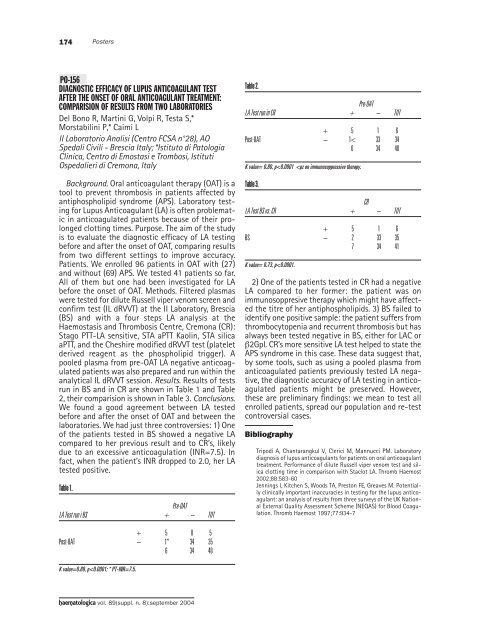XVIII Congress of the Italian Society for Hemostasis and Thrombosis Research, Rome, Sept. 30-Oct. 3, <strong>2004</strong>173PO-154LOW DOSE ORAL VITAMIN K TO RESTORE NORMAL LEVELS OFINR AND COAGULATION FACTORS IN PATIENTS ELECTIVELYDISCOUNTINUING WARFARIN: A RANDOMIZED CONTROLLEDSTUDYAge<strong>no</strong> W,* Manfredi E,* Micieli E,* Crowther M°*Department of Clinical Medicine, University ofInsubria, Varese, Italy and °Department of Medicine,McMaster University, Hamilton, CanadaPatients on warfarin therapy must temporarilyinterrupt their treatment when undergoing an electivesurgical procedure. Low-dose oral vitamin K canshorten the time period during which patients havesubtherapeutic anticoagulation, thus obviating theneed for bridging therapy. We assessed whether oralvitamin K produces an INR fall into a range that isconsidered safe for surgery, and whether the levelsof the vitamin K dependent coagulation factorsincrease to restore the integrity of the coagulationcascade. Patients receiving warfarin for more than 30days with a target INR between 2.0 and 3.0 whowere electively discontinuing warfarin receivedeither 2.5 mg of oral vitamin K or placebo. Plasmasamples were analyzed for INR and for functionallevels of factors II, VII and V on days 0 (immediatelyprior to study drug), 1, 2, 3 and 5. Thirty patientswere enrolled from 2 clinical centers. The INR in theplacebo group declined by 0.26 INR units (from 1.94to 1.68), compared with 1.31 INR units in the vitaminK group (from 2.58 to 1.27, p 0.007). On the dayafter study drug 6 of 15 patients allocated to placebo,compared with 10 of 15 allocated to vitamin K,had an INR less than 1.4. On the second day after vitaminK administration, these proportions were 6 of15 and 14 of 15 (p < 0.01). The levels of factor VIIincreased more quickly over the first 24 hours in thevitamin K group than in the placebo group (meandifference 0.47 U [95% confidence interval (CI)0.28,0.66] compared with 0.10 U [0.03,0.17], p =0.002). The average rise in the factor II level was 0.27U [0.17,0.37] in patients allocated to vitamin K, comparedwith 0.06 U [0.01,0.11] in patients allocated toplacebo (p = 0.001). Our results support the potentialuse of low doses of oral vitamin K in patients whorequire correction of their INR, for elective surgery orother interventions, between 24 to 48 hours after itsadministration.PO-155IQC AND EQC FOR COAGULATION DIAGNOSTICS PARAMETERSMalatesti V, Di Maira G, Mori MDivision of Laboratory Medicine E.O. Galliera Ge<strong>no</strong>a,italyWe report our present experience with a web-basedexternal quality control system for coagulation diag<strong>no</strong>sticsparameters. We are using prothrombin time,activated partial thromboplastin time, fibri<strong>no</strong>genassay as screening coagulation tests. Oral anticoagulanttherapy is monitored by <strong>no</strong>ting changes in a tissuefactor-induced coagulation time (PT) test on plasmaand expressed as INR. We made a summary reportof internal and external QC of some coagulation testsin Division of Laboratory Medicine, Galliera Hospital.Quality Control schemes are valuable to investigateour performance in daily practice. Our approach todata management is Biorad QC On-Call, an integrated,web-based, quality control system that allows toplain our quality control strategy and put operatingrules into practise. The system incorporates currentlyavailable reference standards, medical relevance andbiological variability, which allow our laboratory todefine the maximum error for each analyte and set a<strong>no</strong>perative rule to reach the required quality standard.This tool includes a polling function, which automaticallyimport an LIS QC data file without user intervention.The system includes an extensive graphmenu, including performance reports and graphics;we have a review of daily quality control data and theinterlaboratory reports, which provides a fast evaluatio<strong>no</strong>f quality control trends across peer and methodgroups. The control graphs, multilevel and evolutiongraphs such as Levey-Jennings charts support our laboratoryto optimise the statistical rules for qualitycontrol evaluation. This strategy provides to eliminate<strong>no</strong>nessential reset and calibrations saving time andmoney. Analytical goals help improvement of laboratorystatus performance by providing valuable informationabout the appropriateness of the process controlsystem, using tools based on biological variation,medical relevance, and state of the art performancemetrics.haematologica vol. <strong>89</strong>(suppl. n. 8):september <strong>2004</strong>
174PostersPO-156DIAGNOSTIC EFFICACY OF LUPUS ANTICOAGULANT TESTAFTER THE ONSET OF ORAL ANTICOAGULANT TREATMENT:COMPARISION OF RESULTS FROM TWO LABORATORIESDel Bo<strong>no</strong> R, Martini G, Volpi R, Testa S,*Morstabilini P,* Caimi LII Laboratorio Analisi (Centro FCSA n°28), AOSpedali Civili - Brescia Italy; *Istituto di PatologiaClinica, Centro di Emostasi e Trombosi, IstitutiOspedalieri di Cremona, ItalyBackground. Oral anticoagulant therapy (OAT) is atool to prevent thrombosis in patients affected byantiphospholipid syndrome (APS). Laboratory testingfor Lupus Anticoagulant (LA) is often problematicin anticoagulated patients because of their prolongedclotting times. Purpose. The aim of the studyis to evaluate the diag<strong>no</strong>stic efficacy of LA testingbefore and after the onset of OAT, comparing resultsfrom two different settings to improve accuracy.Patients. We enrolled 96 patients in OAT with (27)and without (69) APS. We tested 41 patients so far.All of them but one had been investigated for LAbefore the onset of OAT. Methods. Filtered plasmaswere tested for dilute Russell viper ve<strong>no</strong>m screen andconfirm test (IL dRVVT) at the II Laboratory, Brescia(BS) and with a four steps LA analysis at theHaemostasis and Thrombosis Centre, Cremona (CR):Stago PTT-LA sensitive, STA aPTT Kaolin, STA silicaaPTT, and the Cheshire modified dRVVT test (plateletderived reagent as the phospholipid trigger). Apooled plasma from pre-OAT LA negative anticoagulatedpatients was also prepared and run within theanalytical IL dRVVT session. Results. Results of testsrun in BS and in CR are shown in Table 1 and Table2, their comparision is shown in Table 3. Conclusions.We found a good agreement between LA testedbefore and after the onset of OAT and between thelaboratories. We had just three controversies: 1) Oneof the patients tested in BS showed a negative LAcompared to her previous result and to CR’s, likelydue to an excessive anticoagulation (INR=7.5). Infact, when the patient’s INR dropped to 2.0, her LAtested positive.Table 1.Pre-OATLA Test run i BS + − TOTTable 2.Pre-OATLA Test run in CR + − TOT+ 5 1 6Post-OAT − 1< 33 346 34 40K value= 0.80, p
















